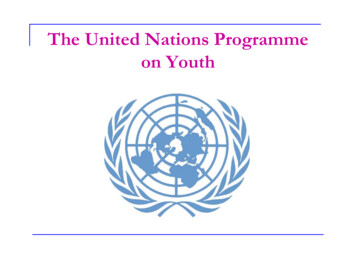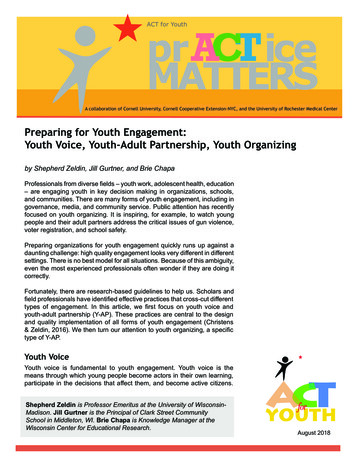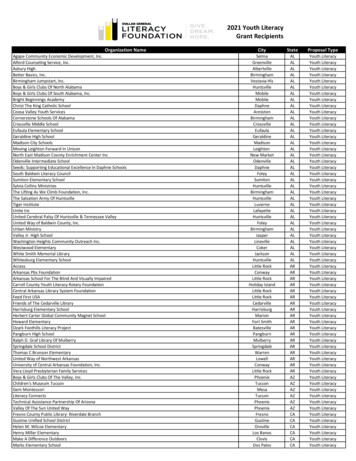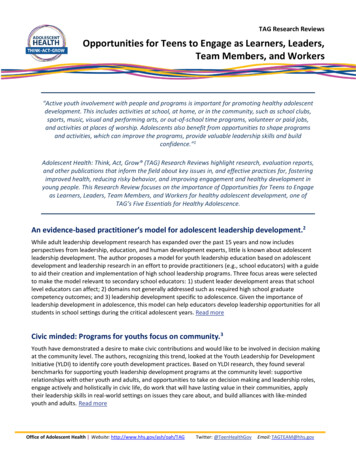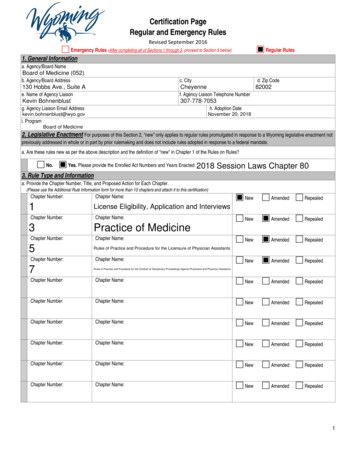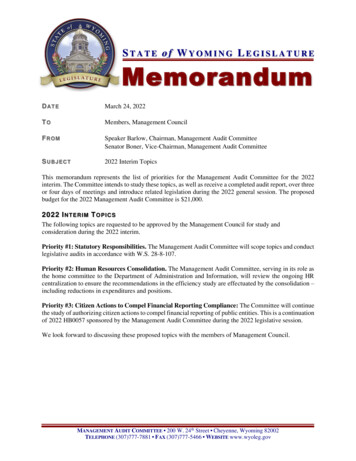
Transcription
Youth Treatment CenterNovember 1995EXECUTIVE SUMMARYThe state of Wyoming funds a variety of community-based andresidential treatment programs for at-risk youth. According tostatutes, adolescents in need of services are required to be placedin the least restrictive setting considered appropriate for theirindividual needs.Young persons generally enter the youth services system through thecourts. Multi-disciplinary teams at the community level advisejuvenile court judges regarding appropriate placements.The Youth Treatment Center (YTC) is oneof services available for at-risk youthlong-term residential program providingsocial services to address the multipleyouth.component of the continuumin Wyoming. YTC is aeducation, health, andproblems of high-riskAccording to YTC's management, treating traumatized children is atthe forefront of its service mission, and many of the residentshave been emotionally, physically, or sexually abused. Someresidents have mental illnesses such as severe depression, whileothers exhibit behavior disorders. Many of the youth also have ahistory of abusing substances.For FY 1995, we estimate that it cost an average of 140 per day toprovide services for each resident admitted to YTC. Based on amedian stay of 8.5 months, an average treatment cost would be morethan 35,000. YTC has an average census of 38.7, and in the courseof a year, serves 90 to 100 adolescents.Finding 1Planning and Coordinating WeaknessesLimit YTC's EffectivenessAlthough YTC's accomplishments are not well documented,knowledgeable individuals we interviewed generally agreed thattreatment at the Center can have a positive impact on youth.However, these individuals also recognized a need for improvedplanning and interagency coordination. The combination ofineffective treatment planning and weak coordination of transitionstends to extend time for treatment and also limit sustainablebenefits of therapy.Although YTC has been a part of DFS since reorganization in 1991,DFS has not clearly outlined for YTC its expectations regardingresidents' treatment planning and coordination of transitions.This lack of management direction has allowed problems to developand go unaddressed.Recommendation:DFS should develop and implement a comprehensive
strategy to strengthen planning for treatment, transitions, andaftercare.Treatment outcomes for YTC residents can be improved if DFSdevelops a strategy to address system problems in the areas oftreatment, transitioning, and aftercare. The resulting strategyshould require DFS and YTC to establish management controls whichguarantee that new planning and coordinating procedures areeffectively carried out.Finding 2Human Resources Management Problems HaveResulted in High Staff TurnoverIneffective human resources management at YTC has resulted in anexcessive staff turnover rate. YTC's turnover rates for 1994 and1995 were 36.8 percent and 39.7 percent respectively. These rateswere more than triple the turnover rate for all state employees,and more than double the rates at either the Girls' or Boys'Schools.YTC has not effectively identified and addressed the causes of itshigh staff turnover rates. Current and former employees attributedturnover primarily to management practices, not to pay. Severalformer employees told us they were so dissatisfied that theyresigned without having new employment to go to.Recommendation: DFS should review human resources managementpractices at YTC and take appropriate actions to resolve problems.Specific steps to improve human resources management could includesome of the following: improving internal communications,establishing an ongoing team building training program, reviewingYTC's organization structure to determine if there are anappropriate number of staff at the various levels, developing anemployee recognition program for all levels of employees, anddeveloping employee incentives which may include recognition andaward features.Finding 3YTC Has Not Addressed Critical FacilityProblemsYTC's aging and inappropriately designed facilities limit staff'sability to supervise residents. Consequently, the state cannot beassured that YTC is providing a safe living and treatmentenvironment for youths placed at the Center.The Center has not presented policymakers with a plan toincrementally address the most critical needs in the existingbuildings. YTC has identified cottage design as presenting thegreatest risks to the residents and the state. Therefore, it hasan obligation to continue informing policymakers of those specificrisks and to justify funding requests for upgrades. YTC's capitaloutlay requests have not reflected this focus.Recommendation: DFS should conduct a systematic assessment ofYTC's facilities to identify and prioritize its most criticalneeds.
DFS should obtain an independent condition assessment of YTC'sfacilities to identify critical building needs. Using theassessment as a guide, YTC should develop a five to seven year planto reduce critical facility deficiencies.Finding 4YTC Has A Serious Runaway ProblemWe found that YTC has an ongoing and severe runaway problem, buthas not identified the causes or effectively addressed the issue.As a result, YTC has exposed its runaways, the community, and thestate to unnecessary risks. YTC does not have a systematic processto review runaways from the Center. It lacks a system to determinethe number of youths who run away, to ascertain the causes ofrunaways, and to strengthen its program and security procedures toreduce the number of runaways.Recommendation:YTC should develop a process to reduce runaways.YTC should develop a system to track the number of residents whorun away, to determine the causes of runaways, to provide stafftraining on prevention, and to strengthen security procedures.These steps should contribute to reduced runaway rates.DFS should require YTC, through rules or written policy, to reportall cases of runaways immediately. In addition, YTC should berequired to provide follow up reporting on steps taken and thedisposition of these cases.Finding 5Customers Are Dissatisfied With YTCResponsivenessInterviews with judges, caseworkers, county attorneys,multi-disciplinary team members, and families depicted a great dealof dissatisfaction with the timeliness and substance of YTCcontact. Many local officials told us they had problemscommunicating with YTC prior to an admission, during treatment, andat the time of release. Ineffective communication diminishes theability of local workers and the courts to effectively meet theneeds of local youth treated at YTC.As a state facility operating within DFS, YTC has an obligation towork within DFS to meet the needs of youth, and also to serve theneeds of local communities. However, due to communication problemswith YTC, officials in several counties have refused to work withYTC. They opt instead to place youth with private providers.Recommendation: YTC should improve responsiveness to its broadrange of customers.YTC needs to recognize it has many customers, including the localofficials who are responsible for youth in treatment. YTC shouldtake steps to identify its diverse clientele, in ways that enhancerather than diminish focus on the residents.YTC should develop rules concerning admission criteria, soplacement officials can have more information about the process.
It should develop a systematic approach for communicating with, andobtaining feedback from, key groups prior to admission, duringtreatment, and at release.Finding 6Quality Control Systems Are Lacking atYTCYTC operates largely without external oversight and internalquality assurance systems which can promote program quality. YTCundergoes no external quality control review by the state or byindependent accrediting entities. Also, YTC lacks an internal,formalized quality assurance system to continually assess andimprove operations.Without these systems, YTC is isolated from the mainstream ofresidential treatment for adolescents. Residents and theirfamilies, the Legislature, and the public have no independentassurance that treatment provided at YTC is appropriate and safe.Recommendation: DFS should develop and implement a plan forproviding effective oversight and internal review at YTC.To protect the interests of its residents and of the state, YTCneeds to be made part of a larger framework. As part of thestrategic planning process, DFS could establish a goal ofdeveloping performance measures related to effective oversight forYTC. All parties stand to benefit from external and internalquality assurance programs at YTC.Because the Management Audit Committee requested a focused studyemphasizing YTC, not the larger youth services system, our findingsand recommendations are intended to strengthen the Center'soperations. However, they necessarily will need to be consideredin a broader context.Policy makers need to be working toward resolution of a number ofrelated and over-arching public policy matters. Questions forconsideration, some of which have been noted in prior studies ofthe youth services system, include:What are the state's expectations for court-orderedplacements?How can YTC best fit into the state's youth servicessystem?Should the YTC continue to provide services which arealso available in the private sector?Which agency should run the state's mental health system?The Legislature faces a fundamental decision regarding YTC: shouldit continue to operate according to status quo, be changed, closed,or is another policy direction desirable?Regardless of which decision is made, we believe the
recommendations in thisreport have implications for the entireyouth services system. They speak to the state's obligation toensure that youth treatment is delivered in an environment andmanner which promote high quality treatment, safety for residents,retention of skilled staff, and attainment of desired outcomes.IntroductionA. ScopeW.S. 28-8-107 (b) authorizes the Legislative Service Office toconduct program evaluations and performance audits. The generalpurpose of a program evaluation is to provide a base of knowledgefrom which policy makers can make informed decisions.In February 1995, the Management Audit Committee chose the YouthTreatment Center in Casper, which is a part of the Department ofFamily Services, as the subject of a review. The Committeerequested that research focus on the Center and its operations,but, to the extent possible, that its operations be reviewed in thecontext of the youth services system.The research in this report centered around the followingquestions:What is YTC's purpose and how effective is it in carryingout that purpose?Are YTC's facilities appropriate to its mission?How are placement decisions made?How comparable are YTC's treatment strategies to acceptedpractices?What is known about outcomes for YTC residents?What supervision and oversight does YTC receive from DFS?B. MethodologyThis evaluation was conducted according to statutory requirementsand appropriate program evaluation standards and methods. Weconducted our research between June and October 1995.We reviewed relevant Wyoming statutes, rules, YTC policies, annualreports, budget requests, academic literature, agency records, anda variety of other state and federal reports and studies. Wecontacted the Department of Health, the Department of Education,and several mental health centers for information. We selected arandom sample of former residents at YTC and reviewed recordspertaining to their placement and release.We interviewed current and former staff at YTC and DFS, as well asformer participants in the program and parents. We traveledthroughout the state to interview District Court judges and membersof multi-disciplinary teams. We toured private residential
treatment centers, the Girls' and Boys' Schools, and severalcommunity based programs for troubled youth.Finally, we conducted telephone interviews and revieweddocumentation from several neighboring and western states,including Alaska, Colorado, and Nebraska.C. AcknowledgementsThe Legislative Service Office would like to express appreciationto all the individuals who assisted us in our research on thisproject, and especially to staff at the Youth Treatment Center andthe Department of Family Services.BackgroundDescription of the Problem of At-Risk YouthWyoming, like all states, faces difficult challenges in decidinghow best to approach the problem of youth whose behavior placesthem at risk of not becoming self sufficient members of society.The Youth Treatment Center (YTC) is one facet of Wyoming's approachto dealing with at-risk youth.One study has estimated that more than 10 percent of the nation'syouth aged 10 to 17 engage in three or more of the four behaviorsmost commonly associated with this risk: poor performance inschool, substance abuse, delinquency, and early unprotected sexualactivity. Many of these children come from troubled families andhave experienced neglect or physical, sexual, or emotional abuse.They may internalize or act out their problems through behaviorsthat range from depression to delinquent acts.Two Basic Approaches to the ProblemOne way to serve high-risk youth is through nonresidentialcommunity-based programs. Such programs serve youths at home, atschool, or through other community locations.Another way of addressing youths' problems is through out of homeplacements. Options range from short-term crisis centers tocomprehensive, long-term (6 to 18 months) residential programs.YTC is a long-term residential program providing education, health,and social services to address the multiple problems of high-riskyouth.Wyoming's Approach to At-Risk YouthThe state of Wyoming funds a variety of community-based andresidential treatment programs for at risk youth. According tostatutes, adolescents in need of services are required to be placedin the least restrictive setting considered appropriate for theirindividual needs.Young persons generally enter the youth services system through thecourts. Juveniles can come under the protection of the courts incases of neglect or abuse. They can be adjudicated delinquent if
they have broken the law or have violated the terms of a courtorder. Juveniles who are out of parental control, such as habitualtruants, chronic runaways, and status offenders can be adjudicatedas children in need of supervision (CHINS). The state gainscustody of those youth ordered to out of home placements.Local and private options for out of home placements include familymembers, foster care, specialized foster care, therapeutic fostercare, group homes, and private residential treatment facilities(RTFs). There are 13 RTFs in Wyoming providing long-termresidential mental health care and special education services.These RTFs have capacities ranging from 14 to 70 beds.The state operates several institutions for youth. DFS isresponsible for the Youth Treatment Center -- a treatment facilityfor adolescents, and two correctional institutions -- the Girls'School and the Boys' School. The Department of Health isresponsible for the State Hospital, which has an adolescentpsychiatric unit.Three agencies are involved in funding court-ordered placements.Generally, DFS pays for room, board and treatment; the StateDepartment of Education (SDE) pays for educational costs; and theDepartment of Health (WDH) pays for medical expenses and certainmental health services. As shown below, both the number ofcourt-ordered placements and expenditures for placements have beenincreasing in recent years.Exhibit 1:Fiscal Year1991199219931994Source:Court-Ordered Placements FY91 through FY94Placements572632682747Expenditures 7,728,838 8,519,865 10,452,141 11,206,008LSO analysis of data from DFS, WDH, and SDEPlacement Decisions are Made LocallyAccording to state statutes, multi-disciplinary teams (MDTs) at thecommunity level advise juvenile court judges regarding appropriateplacements. The composition of these teams varies somewhat fromcommunity to community, but must consist of at least four members,some specified in statutes. Teams often consist of parents orguardians, the youth's legal counsel, school officials, state orlocal social service workers, county attorneys, or otherprofessionals.In making recommendations, MDTs typically consider factors such asthe availability of appropriate local services, immediateavailability of space in preferred facilities, and individualmembers' impressions of program effectiveness. Although MDTmembers consider the cost of various placement options, many do notbelieve this to be their primary consideration. Typically, localDFS offices are responsible for paying for placements, whilejuvenile court judges have the ultimate placement authority.
To initiate the process of making a placement at YTC, a local DFSoffice generally contacts YTC directly. They discuss theappropriateness of placement and the availability of a bed. Someplacements are made immediately, while other youth are put on awaiting list until a bed is available. YTC may advise againstplacement if, for example, staff believe they cannot serve thetreatment needs of the particular youth.Overview of the Youth Treatment CenterThe Youth Treatment Center is one component of the continuum ofservices available for at-risk youth in Wyoming. YTC and privatelyoperated RTFs in the state accept youth with similar problems andprovide similar treatment and educational services.W.S. 25-7-101 authorizes DFS to operate the YTC for the purpose ofproviding special care or treatment for children not otherwiseadequately served. YTC is a residential treatment facility locatednear the center of the state in Casper, on a 24-acre open campus.YTC typically serves male and female adolescents 12 to 18 years oldwho have been adjudicated as delinquent or CHINS. Althoughstatutues allow the placement of delinquents up to age 21, YTCrarely serves individuals over age 18. Many of these adolescentshave experienced several other treatment placements prior to comingto YTC.According to YTC's management, treating traumatized children is atthe forefront of its service mission, and many of the residentshave been emotionally, physically, or sexually abused. Someresidents have mental illnesses such as severe depression, whileothers exhibit behavior disorders. Many of the youth also have ahistory of abusing substances. The Center provides long-term carewith the goal of enabling children to return home or to analternative living situation, able to manage life in a constructivefashion.YTC's program offers mental health services and special educationprograms. Each resident participates in group therapy and may alsorequest individual therapy sessions. The residents work throughthe program on a "level" system, under which they progress towardrelease at individual speed. According to YTC management, thefocus of group therapy and the level system is to empower residentsto help each other through the program. Residents are not requiredto complete the program within a designated time period.Agency officials report that current placement trends involveadolescents requiring more and more acute psychiatric care. Theysay over 50 percent of the youth served at YTC have previouslyreceived acute psychiatric hospital care. Approximately 30 to 40percent of the residents are on psychotropic medications, which aredispensed through a self-administered program.History of the InstitutionYTC's facilities date to the 1930s when they served as the State
Children's Home for orphans. In 1983, YTC changed its focus froma state orphanage to that of a clinically-focused residentialtreatment center and special education school. YTC reported to theBoard of Charities and Reform until 1991, whenit became part of DFS.Budget and StaffingThe Center's budget for the 1995-96 biennium is 3.8 million, whichis a two percent increase over the previous period. The GeneralFund is the source of more than 98 percent of the Center's funds,with Federal Funds contributing less than two percent.As shown in Exhibit 2, nearly 86 percent of FY 95 expenditures werefor residents' room and board, therapeutic services, and education.Exhibit 2:YTC Expenditures by Category Fiscal Year 1995Total Expenditures 1.9 millionSource: LSO analysis of YTC dataYTC is authorized 58 employees: 56 full-time and 2 part-time.They fill a variety of positions which support a program designedaround four residential cottages, staffed 24 hours per day. Manyof the staff work rotating shifts.Each cottage has an assigned therapist who manages the cottage andconducts group and individual therapy sessions. Each cottage alsohas a supervisor who is responsible for day-to-day operations. TheCenter is authorized 24 full-time and one part-time youth serviceworkers. These staff act in a parental role and are responsiblefor such tasks as meal preparation and monitoring and supervisingresidents.Within educational services, YTC employs an education director,five teachers, a Chapter One aide, and a recreation director. YTCalso contracts with a psychiatrist and a physician for mental andmedical health services.Program Costs and Descriptive StatisticsFor FY 1995, we estimate that it cost an average of 140 per day toprovide services for each resident admitted to YTC. Additionally,for the FY95/96 biennium, the Legislature appropriated 352,000 forcapital improvements to the facility. Admissions and releasesoccur throughout the year, with some youth staying only a shortwhile and others for extended periods. Based on a median stay of8.5 months, an average treatment cost would be more than 35,000.YTC has an average census of 38.7, and in the course of a year,serves 90 to 100 adolescents.As a state facility, YTC is a resource to youth from all counties,although admissions are more likely to come from some counties thanfrom others. For the four-year period FY 1992 through FY 1995, YTCadmitted adolescents from 21 of Wyoming's 23 counties. During thattime, 30 or more youths were admitted from two counties, Natronaand Sweetwater. By contrast, only seven admissions came from each
of the following counties:Appendix B].Albany, Campbell, and Laramie [seePlacements After ReleaseAfter successfully completing the fourth and final program "level,"residents may progress to a new placement on a 60-day extendedpass. During this period, YTC still has legal custody of the youtheven though they are no longer in the Center's physical custody.Those youth who are not making progress in the program aretransferred out of the facility to someone else's custody.Residents can be released to any of a variety of settings, rangingfrom less to more restrictive than YTC. Youth may go to grouphomes, therapeutic foster care, back to their families, toindependent living, other residential facilities, psychiatrichospitals, or correctional facilities. Based on our file review,we found that 38 percent of the youth released from YTC returned totheir families.Once released, it is widely accepted that youth need provision foraftercare, or ongoing support and service. As one comprehensiveGovernment Accounting Office (GAO) study found, "a number ofresearch efforts have suggested that a youth's environment afterdischarge is crucial to sustaining the effects of residentialtreatment."High-risk youth are not necessarily "cured" or "fixed" byresidential treatment. In addition, there may be ongoing familyproblems which require counseling and monitoring. Some examples ofaftercare are: continued therapy, substance abuse support groups,home visits by social workers, counseling to help ensure completionof schooling, and assistance in obtaining jobs.Many Earlier Reports Point to System DeficienciesDuring the past 15 years, Wyoming has studied its youth servicessystem many times, through consultant studies, committee reviews,and task forces. Cumulatively, these efforts have produced atleast 13 reports, and many of them contain similar findings aboutWyoming's system:There is no early identification of risk or assessment system inplace.Community resources are limited and not effectively used.There is no consistent process for evaluation of the need forplacement or treatment.There is a lack of clearly defined missions for state agencies andfacilities.There needs to be a clearly defined continuum of care to serve eachtype of child in the system.Because our research was not directed at the youth services system
as a whole, we did not attempt to re-verify these findings.Nevertheless, it is fair to state that we found nothing tocontradict the findings listed above. In addition, it appears thatfew of the recommendations made in these reports have been acted onin the intervening years.None of these reports focused exclusively on YTC's role in servingyouth. The Management Audit Committee, in an effort to shed lighton an as yet unstudied aspect of the system, chose to focus on YTCand its role within the youth services system. Consequently, ourfindings and recommendations focus on what exists at YTC, with aview to how operations might improve.In this report, we identify several areas in which YTC and DFS canimprove: coordination and treatment strategies, staff turnover,deficiencies in the physical plant, the rate of runaways,responsiveness to customer concerns, and oversight and independentscrutiny.Finding 1Planning and Coordinating Weaknesses LimitYTC's EffectivenessAlthough YTC's accomplishments are not well documented,knowledgeable individuals we interviewed generally agreed thattreatment at the Center can have a positive impact on youth.However, these individuals also recognized a need for improvedplanning and interagency coordination. The combination ofineffective treatment planning and weak coordination of transitionstends to extend time for treatment and also limit sustainablebenefits of therapy.To gain an understanding of YTC's operations, we talked to a broadrange of current and former employees and residents, parents,public officials, and professionals in related fields. Wequestioned them about various aspects of the Center's operations,obtained their views concerning its effectiveness, and asked someof them to compare YTC to standards we found in the literatureabout residential programs.In addition, we examined a randomly selected sample of 25 casesadmitted to YTC between September 1, 1992 and August 31, 1994.None of these cases involved current residents. For this sample,we found:The median length of stay was 255 days, or about 8.5 months.The median time from admission until the completion of a writtenindividual treatment plan was 110 days, or about 3.7 months.There was no evidence that any of these plans, once completed, hadbeen revised during treatment to reflect modified goals.17 of our sample of 25 residents (68 percent) were released withoutcompleting their treatment plans.12 of our sample of 25 residents (48 percent) were released to
placements that were equally or more restrictive than YTC.Research Shows Key Characteristics of Effective ProgramsWe reviewed pertinent literature and program evaluations from otherstates to gain an understanding of residential care for at-riskyouth. The U.S. General Accounting Office has identified keyelements believed to be important for the success of residentialtreatment programs. A description of these characteristics isshown in Exhibit 3.Exhibit 3: Characteristics of EffectiveResidential Treatment ProgramsDeveloping Individual Treatment Plans. Nearly all residentialtreatment programs develop individual treatment plans for eachyouth. Plans, in some cases, are updated at specific intervals,such as monthly.Participation of a Caring Adult. The presence of a caring adult,such as a counselor or other staff member, was considered importantin many youths' successful experiences in residential programs.Self-Esteem Building. According to officials from most programs,it is important for residential programs to provide opportunitiesto build self-esteem so that youths can develop a sense of success.Planning for Post-Program Life. Planning for transitions may beginas soon as youths enter the program. Some programs connect youthsto community services and work with families to strengthenrelationships and resolve problems such as substance abuse.Teaching Social, Coping, and Living Skills. One important purposeof residential care is to prepare youths for the everyday world.Youths are taught good work habits, handling confrontations, andpreparing nutritious meals.Coordination of Services. Program officials viewed coordination ofservices as important, whether the services were provided by asingle caseworker or a team.Involving the Family. Programs acknowledge that youths' behaviorsare often related to family problems and dysfunction. Severalprograms contacted involved families in their formal treatmentapproach, although this is not always feasible.Positive Peer Culture. Peer influence is used to effect healthybehavior changes in youths. Program staff work with peer groups tofoster desirable values and behavior patterns.Enforcing a Strict Code of Discipline. Program officials believea strict code of discipline for residents was of great importance.Post-Program Support. Research efforts suggest that a youth'senvironment after discharge is crucial to sustaining the effects ofresidential treatment. Accordingly, some programs continueservices after the youths are discharged from residential care.
Providing a Family-Like Atmosphere. Because many at-risk youthshave not grown up in constructive family environments, severalprograms helped youths develop skills and relationships in ahealthy family-like setting.Source:U.S. General Accounting OfficeDFS Has Not Provided YTC With Clear DirectionsAlthough YTC has been a part of DFS since reorganization in 1991,DFS has not clearly outlined for YTC its expectations regardingresidents' treatment planning and coordination of transitions.This lack of management direction has allowed
The Youth Treatment Center (YTC) is one component of the continuum of services available for at-risk youth in Wyoming. YTC is a long-term residential program providing education, health, and social services to address the multiple problems of high-risk youth. According to YTC's management, treating traumatized children is at
